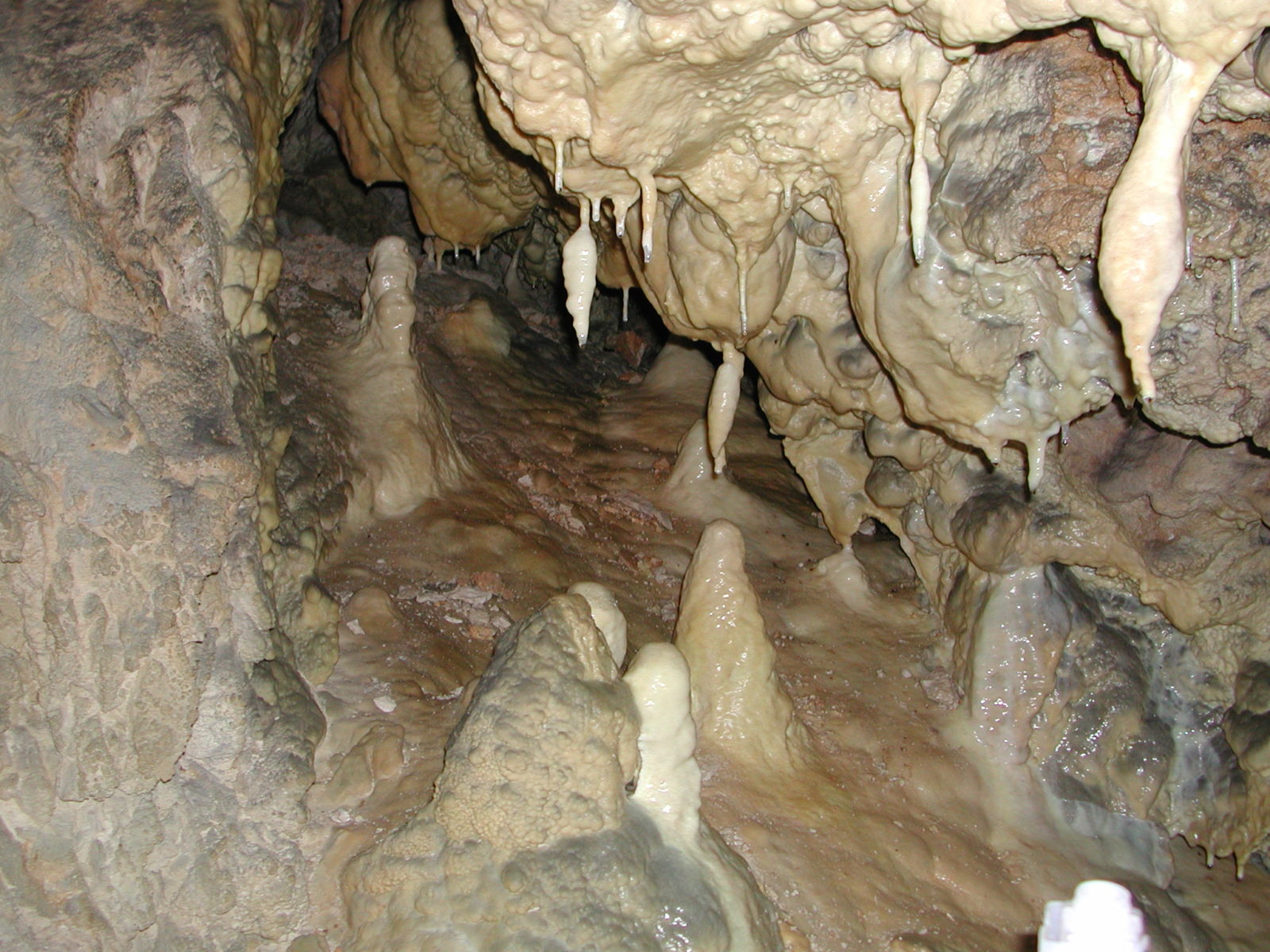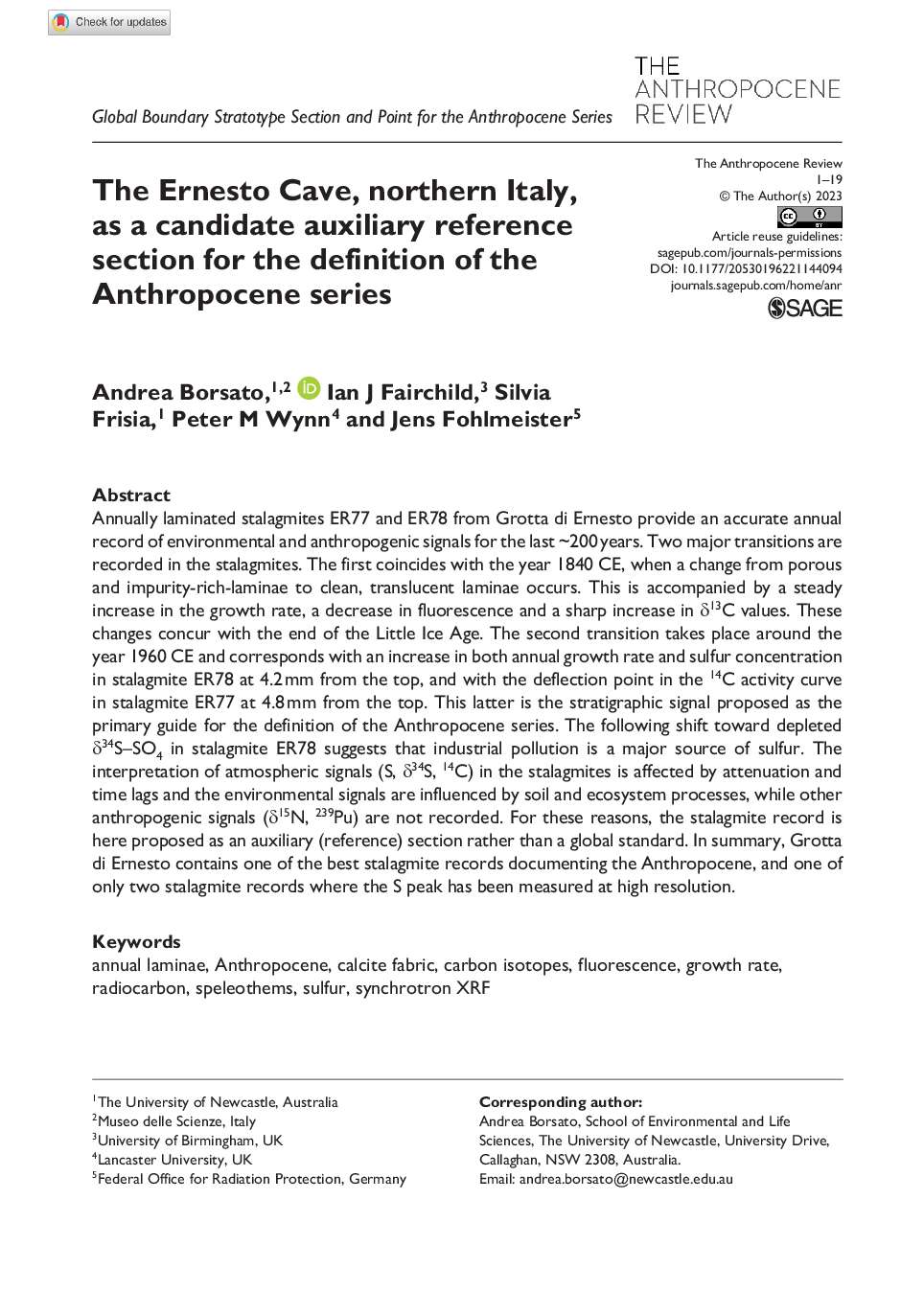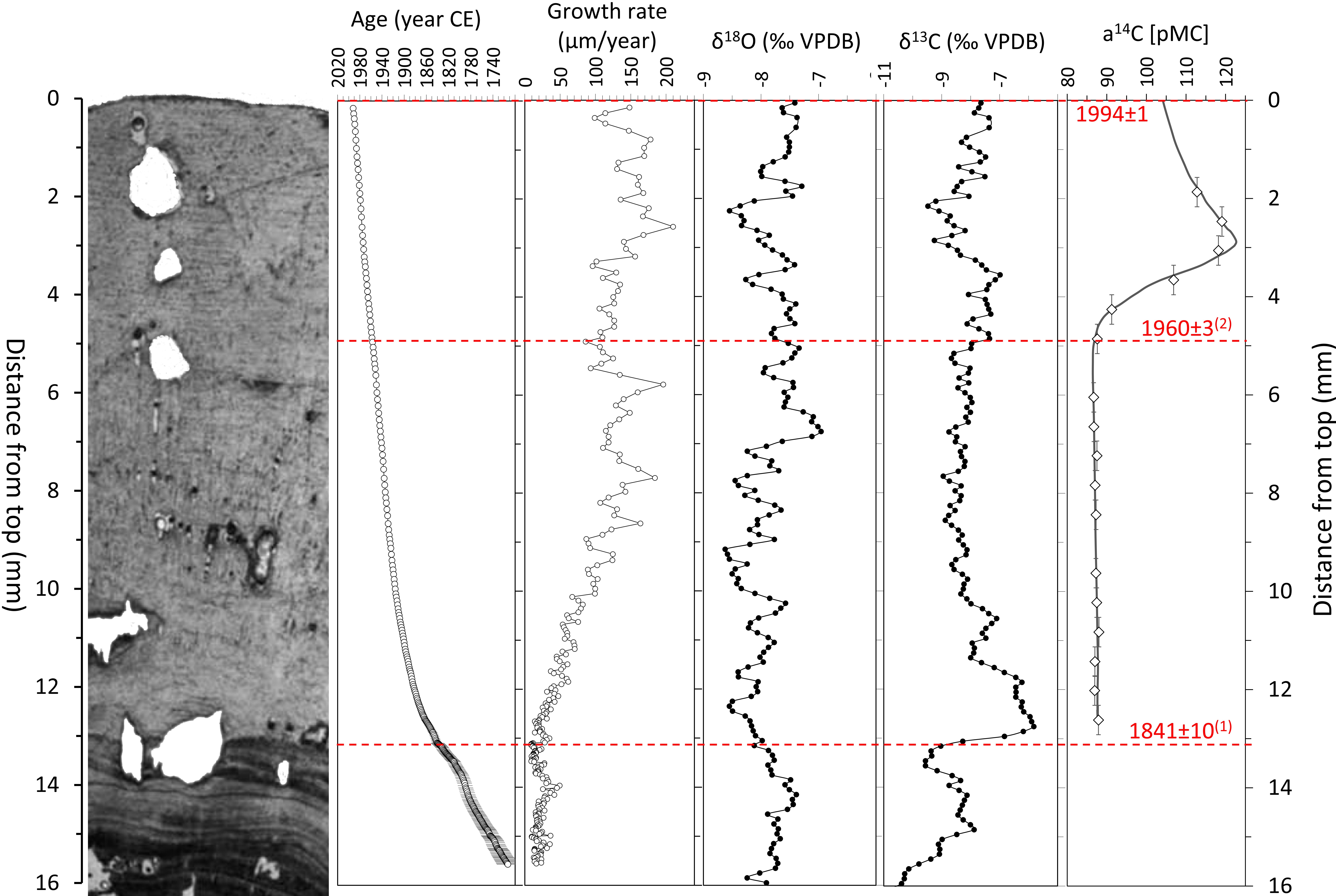Ernesto Cave, Italy

Site Introduction
Ernesto Cave (Grotta di Ernesto) is a small cave in Northern Italy’s mountainous Trentino province. The steep, north-facing slope of the Asiago Plateau on which it is situated is covered with a forest of beech, spruce, and silver fir and overlooks the deep Sugana Valley. The cave is situated 1,167 meters above sea level and consists of a seventy-meter-long descending gallery that opens into three successive chambers: Sala del Focolare, Sala Grande, and Sala Terminale. Active stalagmites and stalactites decorate the passages, courtesy of the porous overlying Jurassic limestone.
Ernesto Cave was discovered in the autumn of 1983, during excavations for road construction, and takes its name from the boy who was first to enter since the entrance was blocked by debris around 8,000 years ago. Inside was evidence of human activity dating to the Mesolithic period (around 9,000 years ago), including a hearth and some animal bones bearing tool marks. The cave was reclosed with an iron door to prevent disturbance by humans or animals and to preserve the natural ventilation patterns.
The forest above the cave is only around eighty years old, since the area was cleared to facilitate military operations prior to World War I. On May 15, 1916, the Asiago Plateau—located on the frontline between Austria-Hungary and Italy—was the site of a major battle, in which 25,000 people died.
Location of the Core
The GSSP1 candidate for Ernesto Cave is not a core but rather stalagmites cut from the cave floor, which grew for the last 8,500 years. Speleothems (including stalagmites, which grow up from the floor, and stalactites, which hang down like stone icicles) are formed when water filters through limestone and drips into a cave. When the water loses excess carbon dioxide, it deposits calcium carbonate—a process that, over thousands of years, forms the spikes and spires that decorate underground chambers. The annual layers of stalagmites and stalactites thus constitute extremely long-running archives. Because Ernesto Cave is relatively small, largely undisturbed (it is closed to the public), and has been well-studied since the early 1990s, the records held in its speleothems can be used to form accurate pictures of past environmental and climatic conditions.
The average rate of stalagmite growth in Ernesto Cave is around 0.1 millimeters per year, with two distinct layers: most of the growth is pale colored, being made up of translucent, non-fluorescent2 calcite (up to approximately 200 micrometers thick), and a thin, brown layer of fluorescent calcite (0.5–4 micrometers thick) forms in autumn. The fluorescence and dark color originates from soil-derived organic matter, which is flushed into the cave during autumn rainfall. Another imprint of the seasons is the sulfate content in the stalagmite: lower levels of carbon dioxide increase the pH3 of the drip water, which in turn increases the sulfate. Over centuries, sulfate levels also change depending on pollution inputs.
Because of the small number of comparable stalagmites at the site, it is not possible to obtain further samples containing the same material (as is possible with sediment cores), although other similar stalagmites in the cave demonstrate the reproducibility of the material. Given the extremely slow rate of growth, the total material that constitutes the Anthropocene in the Ernesto Cave stalagmites is only around five millimeters thick—therefore providing much less total material for analysis.
The Core and Results
The Ernesto Cave annually laminated stalagmites record both local and global anthropogenic signals. Whereas some signals (such as the seasonal flushing of soil-derived organic matter) are transmitted practically instantaneously, others are delayed by storage and biomineralization in the soil and vegetation. Thus, signals such as sulfate concentration or carbon-14 have a variable lag (of up to fifteen years) between the date of environmental input and the date of incorporation into the stalagmite layer.
At around 1840, there are various changes which document the end of the Little Ice Age.4 There is a decrease in organic content as the warmer temperatures enabled more efficient degradation of organic matter in the soil above, as well as an increase in carbon-13 and stalagmite growth rate (caused by increased dissolution of calcium carbonate as a result of higher carbon dioxide production in the soil). At the beginning of the twentieth century, there are increased trace elements and organic matter which document the deforestation that occurred to facilitate military operations before World War I. Then, at 1960 there is another increase in stalagmite growth rate following a rise in surface temperature, as well as increased sulfur from industrial pollution. At the same time there is also a rise in the carbon-14 in response to the mid-century bomb pulse,5 when nuclear testing increased levels of carbon-14 in the atmosphere.
Thin section image in transmitted and fluorescent light (470 nm) of the topmost section of ER78 stalagmite compared with the annual growth rate and age model derived from layer counting, the fluorescence signal, the S concentration composition and the δ34S–SO4. Four time markers are highlighted: 1) The passage between microcrystalline porous to compact columnar calcite at 8.6 mm dft (age 1836±15 CE); 2) The peak in sulphur concentration at 8.4 mm dft (lamina age 1884±7 CE), possibly related to the Krakatoa volcanic eruption in August 1883; 3) The increase in the annual growth rate and S concentration, and the following shift towards depleted δ34S–SO4 that suggests an additional source of stalagmite sulphur originating from industrial pollution; 4) The sudden increase of growth rate along a thin micro-detrital layer that correspond to the opening of the cave entrance and archaeological excavation carried out in summer 1984. Image by Andrea Borsato © All Rights Reserved Thin section image in transmitted light of the topmost section of ER77 stalagmite compared with the age model derived from annual layer counting, the oxygen and carbon isotope composition, and the 14C activity. Two time-markers are highlighted: 1) The passage between microcrystalline porous to compact columnar calcite at 13.1 mm dft (lamina age 1841±10 CE) marked by a steady increase in the growth rate and a sharp rise in δ13C; 2) The deflection point in the 14C activity curve. Image by Andrea Borsato © All Rights Reserved
Collection and Analysis
Three active stalagmites were removed from the cave: ER76 in June 1993, ER77 in November 1995 (the forty-five-centimeter-long GSSP candidate), and ER78 in October 2000. The stalagmites were removed at their bases by chisel and hammer, and transported to the Science Museum in Trento. Each stalagmite was cut along its growth axis, and the two halves were sliced into 10–12-millimeter-long slabs, which were polished and scanned with a flatbed scanner before being cut into thin sections for geochemical analyses. Most of the pieces are now held in the geological sample collection at the Trento Science Museum.
The stalagmite samples were subjected to various analyses, including petrography and microstratigraphy, optical fluorescence imaging, annual laminae counting, uranium-thorium dating, stable isotope analyses, radiocarbon analyses, synchrotron radiation-based and ion microprobe sulfur and trace element concentration analyses, and sulfur isotope analyses.
The Research Team
The Ernesto Cave research team formed in 1994 when the cave was selected as a study site in the framework of the paleoclimate EU Project EV5V-CT94-0509. The initial group consisted of Silvia Frisia, who led the project, and Andrea Borsato, based at the Museo Tridentino di Scienze Naturali (MTSN; renamed in 2013 as Museo delle Scienze) in Trento, and Ian Fairchild from the University of Birmingham in the UK. Following the initial European project, the MTSN research team was supported by two grants from the Autonomous Province of Trento (1998–2005) and continued to collaborate with Fairchild in a wide range of successor projects, including an innovative soil-to-cave study of carbon dioxide levels and carbon isotopes and their potential relationship to the Anthropocene.
Following the demonstration of historical changes in sulfate abundance in Ernesto speleothems (Frisia et al. in 2005), Fairchild investigated this area in depth with a grant funded by the UK Natural Environment Research Council (NERC), employing Peter Wynn as a postdoctoral researcher (2005–7). The work involved devising new methods of isotope analysis of sulfate in calcite, experimental work, and work on parallel archives of trees near the cave site. Stimulated by Borsato et al.’s (2007) work on high-resolution trace element records, Adam Hartland carried out part of his PhD studies with Fairchild on colloid analyses in cave waters, funded by another NERC grant.
In 2005, Ernesto Cave also became a site of German Research Foundation (DFG) Research Group 668 (DAPHNE), coordinated by the Heidelberg Academy of Sciences, which supported long-term cave and soil monitoring carried out by Frisia and Renza Miorandi. The DAPHNE project investigated in detail the influences of hydrology on the radiogenic and stable carbon isotope composition of cave drip water, as well as the radiocarbon bomb peak in stalagmite ER77 within the PhD research of Jens Fohlmeister.
In 2007, Frisia accepted a permanent position at the University of Newcastle, Australia, and the MTSN group partially dissolved. However, the research at Ernesto Cave continued, because of the unique quality of the data, which included the first description of stalagmite calcite fabrics based on environmental parameters and submicroscopic scale characteristics.
Today the group continues to evolve, with current interests focusing on calcium carbonate crystal growth and implications for climate proxy data.
Principal investigators (listed alphabetically): Andrea Borsato, University of Newcastle (Australia) and Museo delle Scienze di Trento Silvia Frisia, University of Newcastle (Australia) and Museo delle Scienze di Trento Ian Fairchild, University of Birmingham Contributing Scientists/Researchers (listed alphabetically): Massimo Bernardi, Museo delle Scienze di Trento, Stalagmite archiving Flavio Corradini, Fondazione Edmund Mach, Sulphur analyses John Craven, Edinburgh Ion Microprobe Facility, Ion microprobe analysis Anna de Momi, University of Birmingham, Environmental monitoring and sampling Jens Fohlmeister, University of Heidelberg, Potsdam Institute for Climate Impact Research, Germany Radiocarbon analysis Adam Hartland, University of Birmingham/now University of Waikato, Trace element analysis (colloids) Richard Hinton, Edinburgh Ion Microprobe Facility, Ion microprobe analysis Bernd Kromer, University of Heidelberg, Radiocarbon analysis Jonathan Lageard, Manchester Metropolitan University, Dendrochronology Nicola La Porta, Fondazione Edmund Mach, Dendrochronology Neil Loader, University of Swansea, Carbon isotope analysis Augusto Mangini, University of Heidelberg, Project co-ordination Frank McDermott, University College Dublin, Ireland, Uranium-series analyses Renza Miorandi, Museo delle Scienze di Trento, Cave environmental monitoring Manfred Mudelsee, Climate Risk Analysis, Hannover, Statistical analysis Nereo Preto, University of Padova, Statistical analysis Denis Scholz, Johannes Gutenberg University Mainz, Uranium-series analyses Andrea Schröder-Ritzrau, University of Heidelberg, Radiocarbon analysis Andrea Somogyi, European Synchrotron Radiation Facility, SR-XRF trace element analyses Christoph Spoetl, University of Innsbruck, Stable isotope analysis Jean Susini, European Synchrotron Radiation Facility, SR-XRF trace element analyses Peter Thomas, Keele University, Dendrochronology Peter Wynn, University of Birmingham and University of Lancaster, Sulphur, Sulphur isotope analysis Michele Zandonati, Museo delle Scienze di Trento, Environmental monitoring and sampling


This article is distributed under the terms of the Creative Commons Attribution-NonCommercial 4.0 License (https://creativecommons.org/licenses/by-nc/4.0/) which permits non-commercial use, reproduction and distribution of the work without further permission provided the original work is attributed as specified on the SAGE and Open Access page (https://us.sagepub.com/en-us/nam/open-access-at-sage).
- Borsato, Andrea, Silvia Frisia, and Renza Miorandi. 2015. “Carbon Dioxide Concentration in Temperate Climate Caves and Parent Soils over an Altitudinal Gradient and Its Influence on Speleothem Growth and Fabrics: Carbon Dioxide Concentration in Temperate Climate Caves and Soils.” Earth Surface Processes and Landforms 40 (9): 1158–70. doi:10.1002/esp.3706.
Borsato, Andrea, Silvia Frisia, Ian J Fairchild, Andrea Somogyi, and Jean Susini. 2007. “Trace Element Distribution in Annual Stalagmite Laminae Mapped by Micrometer-Resolution X-Ray Fluorescence: Implications for Incorporation of Environmentally Significant Species.” Geochimica et Cosmochimica Acta 71 (6): 1494–1512. doi:10.1016/j.gca.2006.12.016.
Borsato, Andrea, Silvia Frisia, Peter M Wynn, Ian J Fairchild, and Renza Miorandi. 2015. “Sulphate Concentration in Cave Dripwater and Speleothems: Long-Term Trends and Overview of Its Significance as Proxy for Environmental Processes and Climate Changes.” Quaternary Science Reviews 127: 48–60. doi:10.1016/j.quascirev.2015.05.016.
Borsato, Andrea, Vanessa E Johnston, Silvia Frisia, Renza Miorandi, and Flavio Corradini. 2016. “Temperature and Altitudinal Influence on Karst Dripwater Chemistry: Implications for Regional-Scale Palaeoclimate Reconstructions from Speleothems.” Geochimica et Cosmochimica Acta 177: 275–97. doi:10.1016/j.gca.2015.11.043.
Fairchild, Ian J, Andrea Borsato, Anna F Tooth, Silvia Frisia, Christopher J Hawkesworth, Yiming Huang, Frank McDermott, and Baruch Spiro. 2000. “Controls on Trace Element (Sr–Mg) Compositions of Carbonate Cave Waters: Implications for Speleothem Climatic Records.” Chemical Geology 166 (3): 255–69. https://doi.org/10.1016/S0009-2541(99)00216-8.
Fairchild, Ian J, Andy Baker, Andrea Borsato, Silvia Frisia, Richard W Hinton, Frank McDermott, and Anna F Tooth. 2001. “Annual to Sub-Annual Resolution of Multiple Trace-Element Trends in Speleothems.” Journal of the Geological Society 158 (5): 831–41. https://doi.org/10.1144/jgs.158.5.831.
Fairchild, Ian J, Neil J Loader, Peter M Wynn, Silvia Frisia, Peter A Thomas, Jonathan G. A Lageard, Anna de Momi, et al. 2009. “Sulfur Fixation in Wood Mapped by Synchrotron X-Ray Studies: Implications for Environmental Archives.” Environmental Science & Technology 43 (5): 1310–15. https://doi.org/10.1021/es8029297.
Fairchild, Ian J., and Silvia Frisia. 2014. “Definition of the Anthropocene: a View from the Underworld.” Geological Society Special Publication 395 (1): 239–54. https://doi.org/10.1144/SP395.7.
Fohlmeister, J, A Schröder-Ritzrau, C Spötl, S Frisia, R Miorandi, B Kromer, and A Mangini. 2010. “The Influences of Hydrology on the Radiogenic and Stable Carbon Isotope Composition of Cave Drip Water, Grotta Di Ernesto (Italy).” Radiocarbon 52 (4): 1529–44. https://doi.org/10.1017/S0033822200056289.
Fohlmeister, J, B Kromer, and A Mangini. 2011. “The Influence of Soil Organic Matter Age Spectrum on the Reconstruction of Atmospheric 14C Levels Via Stalagmites.” Radiocarbon 53 (1): 99–115. https://doi.org/10.1017/S003382220003438X.
Fohlmeister, J, D Scholz, B Kromer, and A Mangini. 2011. “Modelling Carbon Isotopes of Carbonates in Cave Drip Water.” Geochimica et Cosmochimica Acta 75 (18): 5219–28. https://doi.org/10.1016/j.gca.2011.06.023.
Frisia, Silvia, Andrea Borsato, and Jean Susini. 2008. “Synchrotron Radiation Applications to Past Volcanism Archived in Speleothems: An Overview.” Journal of Volcanology and Geothermal Research 177 (1): 96–100. https://doi.org/10.1016/j.jvolgeores.2007.11.010.
Frisia, Silvia, Andrea Borsato, Ian J Fairchild, and Jean Susini. 2005. “Variations in Atmospheric Sulphate Recorded in Stalagmites by Synchrotron Micro-XRF and XANES Analyses.” Earth and Planetary Science Letters 235 (3): 729–40. https://doi.org/10.1016/j.epsl.2005.03.026.
Frisia, Silvia, Andrea Borsato, Nereo Preto, and Frank McDermott. 2003. “Late Holocene Annual Growth in Three Alpine Stalagmites Records the Influence of Solar Activity and the North Atlantic Oscillation on Winter Climate.” Earth and Planetary Science Letters 216 (3): 411–24. https://doi.org/10.1016/S0012-821X(03)00515-6.
Frisia, Silvia, Ian J Fairchild, Jens Fohlmeister, Renza Miorandi, Christoph Spötl, and Andrea Borsato. 2011. “Carbon Mass-Balance Modelling and Carbon Isotope Exchange Processes in Dynamic Caves.” Geochimica et Cosmochimica Acta 75 (2): 380–400. https://doi.org/10.1016/j.gca.2010.10.021.
Hartland, Adam, Ian J Fairchild, Jamie R Lead, Andrea Borsato, Andy Baker, Silvia Frisia, and Mohammed Baalousha. 2012. “From Soil to Cave: Transport of Trace Metals by Natural Organic Matter in Karst Dripwaters.” Chemical Geology 304-305: 68–82. https://doi.org/10.1016/j.chemgeo.2012.01.032.
Huang, YiMing, Ian J Fairchild, Andrea Borsato, Silvia Frisia, Nigel J Cassidy, Frank McDermott, and Chris J Hawkesworth. 2001. “Seasonal Variations in Sr, Mg and P in Modern Speleothems (Grotta Di Ernesto, Italy).” Chemical Geology 175 (3): 429–48. https://doi.org/10.1016/S0009-2541(00)00337-5.
Johnston, V. E, A Borsato, C Spötl, S Frisia, and R Miorandi. 2013. “Stable Isotopes in Caves over Altitudinal Gradients: Fractionation Behaviour and Inferences for Speleothem Sensitivity to Climate Change.” Climate of the Past 9 (1): 99–118. https://doi.org/10.5194/cp-9-99-2013.
McDermott, Frank, Silvia Frisia, Yiming Huang, Antonio Longinelli, Baruch Spiro, Tim H.E. Heaton, Chris J. Hawkesworth, et al. 1999. “Holocene Climate Variability in Europe: Evidence from δ18O, Textural and Extension-Rate Variations in Three Speleothems.” Quaternary Science Reviews 18 (8-9): 1021–38. https://doi.org/10.1016/S0277-3791(98)00107-3.
Miorandi, Renza, Andrea Borsato, Silvia Frisia, Ian J Fairchild, and Detlev K Richter. 2010. “Epikarst Hydrology and Implications for Stalagmite Capture of Climate Changes at Grotta Di Ernesto (NE Italy): Results from Long-Term Monitoring.” Hydrological Processes 24 (21): 3101–14. https://doi.org/10.1002/hyp.7744.
Scholz, D, S Frisia, A Borsato, C Spötl, J Fohlmeister, M Mudelsee, R Miorandi, and A Mangini. 2012. “Holocene Climate Variability in North-Eastern Italy: Potential Influence of the NAO and Solar Activity Recorded by Speleothem Data.” Climate of the Past 8 (4): 1367–83. https://doi.org/10.5194/cp-8-1367-2012.
Smith, Claire L, Andy Baker, Ian J Fairchild, Silvia Frisia, and Andrea Borsato. 2006. “Reconstructing Hemispheric‐scale Climates from Multiple Stalagmite Records.” International Journal of Climatology 26 (10): 1417–24. https://doi.org/10.1002/joc.1329.
Wackerbarth, A, P. M Langebroek, M Werner, G Lohmann, S Riechelmann, A Borsato, and A Mangini. 2012. “Simulated Oxygen Isotopes in Cave Drip Water and Speleothem Calcite in European Caves.” Climate of the Past 8 (6): 1781–99. https://doi.org/10.5194/cp-8-1781-2012.
Wynn, Peter M, Andrea Borsato, Andy Baker, Silvia Frisia, Renza Miorandi, and Ian J Fairchild. 2013. “Biogeochemical Cycling of Sulphur in Karst and Transfer into Speleothem Archives at Grotta Di Ernesto, Italy.” Biogeochemistry 114 (1-3): 255–67. https://doi.org/10.1007/s10533-012-9807-z.
Wynn, Peter M, Ian J Fairchild, Andrea Borsato, Christoph Spötl, Adam Hartland, Andy Baker, Silvia Frisia, and James U.L Baldini. 2018. “Sulphate Partitioning into Calcite: Experimental Verification of pH Control and Application to Seasonality in Speleothems.” Geochimica et Cosmochimica Acta 226: 69–83. https://doi.org/10.1016/j.gca.2018.01.020.
Wynn, Peter M, Ian J Fairchild, Andy Baker, Silvia Frisia, Andrea Borsato, and Renza Miorandi. 2006. “Atmospheric Forcing of Sulphate in Speleothem Carbonate.” Geochimica et Cosmochimica Acta 70 (18): A710–A710. https://doi.org/10.1016/j.gca.2006.06.1541.
Wynn, Peter M, Ian J Fairchild, Silvia Frisia, Christoph Spötl, Andy Baker, and Andrea Borsato. 2010. “High-Resolution Sulphur Isotope Analysis of Speleothem Carbonate by Secondary Ionisation Mass Spectrometry.” Chemical Geology 271 (3): 101–7. doi:10.1016/j.chemgeo.2010.01.001.
Wynn, Peter M, N.J Loader, and I.J Fairchild. 2014. “Interrogating Trees for Isotopic Archives of Atmospheric Sulphur Deposition and Comparison to Speleothem Records.” Environmental Pollution 187: 98–105. https://doi.org/10.1016/j.envpol.2013.12.017.

























